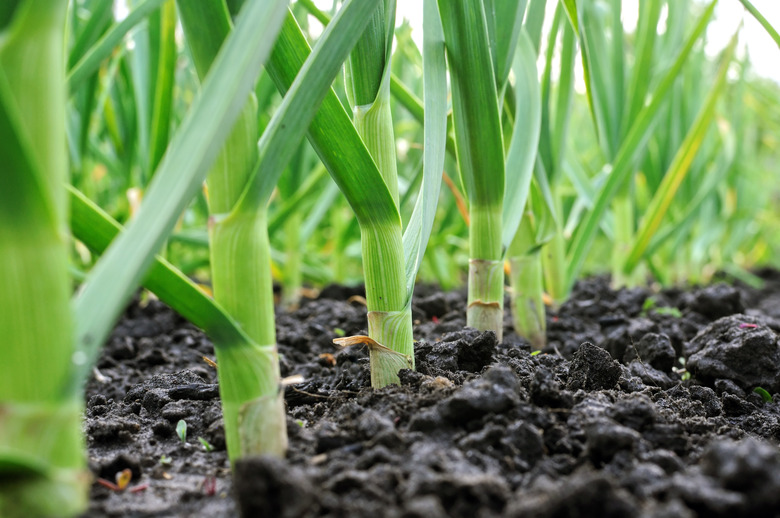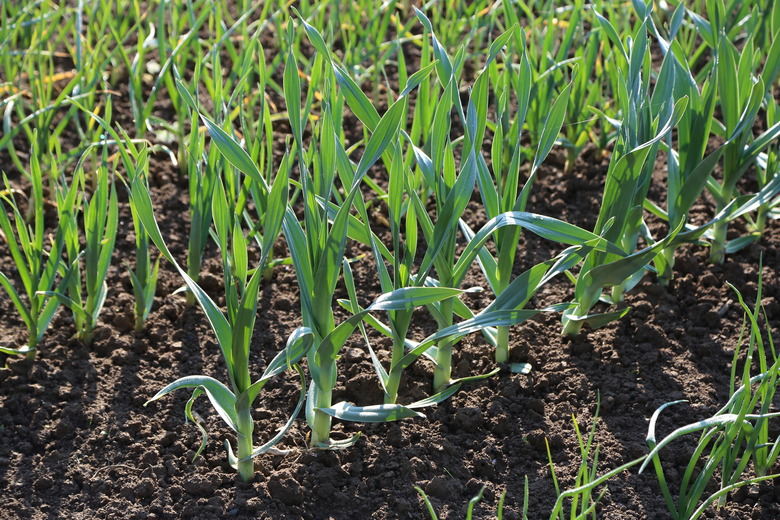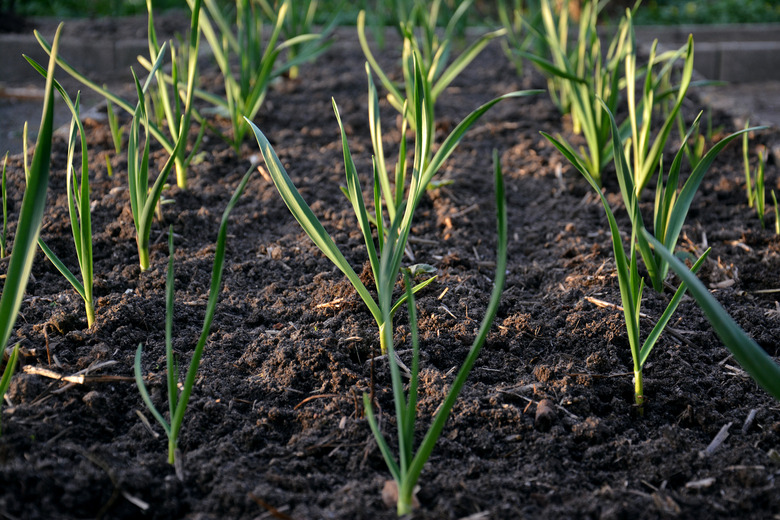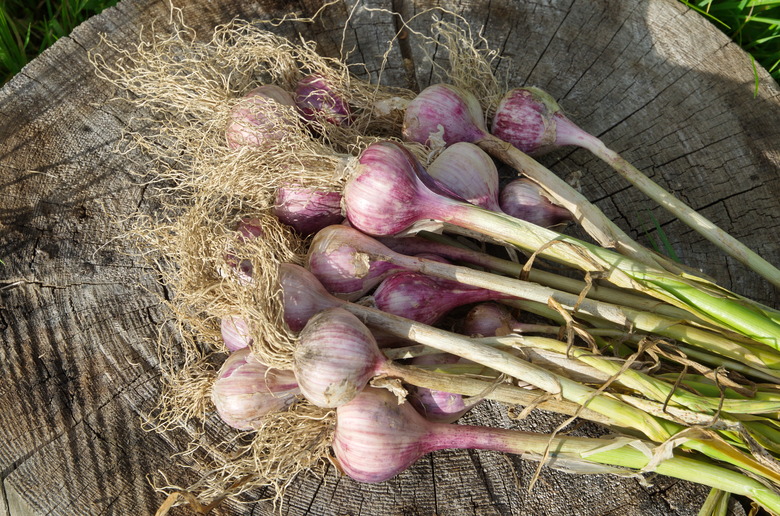How To Grow Garlic
Garlic (Allium sativum) is fairly easy to grow, and garlic plants are popular garden favorites. A low-maintenance plant, garlic makes a fine addition to any vegetable garden, and it doesn't require a lot of care. Garlic grows underground as a bulb much like its family members: onions, leeks and shallots, and there is a nice selection of garden-friendly varieties from which to choose—all of them destined to be used in favorite kitchen recipes.
This plant enjoys a long history in food preparation, but it has also been used medicinally throughout the ages. In fact, garlic can be traced back to Asia, where it originated, and before modern medicine, it held an important place as a remedy for numerous health conditions. Today, garlic is primarily known for its robust, delicious flavor as a seasoning in cooking and is a base ingredient in many popular dishes.
Growing garlic is best done by planting the individual cloves. There are two main varieties of this plant: the softneck and hardneck types of garlic. Hardneck varieties are more cold tolerant and come in a greater number of flavors. This plant works well in more northern (colder) climates in the U.S. This variety also sends up flower stems that are referred to as "scapes," which curl and have a seed head on the end. The softneck variety does not have scapes and is the variety that tends to work well in warmer climates. Softneck garlic is the kind that is typically seen at the grocery store. It is also the type of garlic plant that is able to be braided.
Best Uses for Garlic
Garlic can be planted in raised beds, or it can go directly into the ground. Garlic plants take up less space than many of their vegetable garden counterparts, so a comparatively large number of the cloves can be planted and harvested quite easily. This also means it's possible to grow them in a relatively small section of yard, which can be great for those with small yards and big garden dreams. It is possible to grow this vegetable in a container, but most people opt for a yard planting since it's the most convenient.
Garlic plants don't have an overly attractive appearance, so locating them in the backyard is probably the right pick in terms of placement, as they are not really a feature plant. Sometimes, they may be mixed in with other garden vegetables, but ideally, this bulb should be put in a spot that doesn't collect pooling water or have too much shade, so use caution in terms of what is planted nearby. Garlic is happiest in full sun, so evaluate the yard for a section that fits with that description for best results.
As a side note, many people aren't aware that elephant garlic isn't actually a "true" garlic. This plant is more closely related to leeks and doesn't have the same potency in taste. This means it isn't the best choice in recipes that call for garlic cloves. That said, this large, garlic-looking vegetable can be roasted and used in salads or spreads to take advantage of its milder flavor, though it isn't officially a type of garlic.
How to Grow Garlic
- Common Name: Garlic
- Botanical Name: Allium sativum
- When to Plant: Late fall or early spring
- USDA Zones: 4–9
- Sun Exposure: Full sun
- Soil Type: Loose, fertile, well-draining soil
- When it's in Trouble: When fungus forms due to excess moisture. Possible symptoms include stunted growth, yellowing leaves and rotting of stem
- When it's Thriving: Healthy-looking green stalks that are visible above ground
Starting Garlic From Seed
Garlic is a vegetable or herb that is easily grown by planting a clove of the plant just like a seed. This is usually the easiest way to grow it, as raising from actual seeds is far more difficult. Purchase the garlic cloves from a nursery or order them online because grocery store garlic may not be the right variety for your particular region's climate. In addition, grocery store cloves may carry disease and could introduce that to your soil.
Planting garlic isn't overly complicated. Simply space each garlic clove around 2 to 4 inches apart, plant around 2 inches deep into the soil and cover with soil. Be sure to leave the papery covering on the clove, as it helps to protect it in the ground. The pointy side of the clove should be at the top. Once planted, water the area thoroughly.
Garlic can also be grown from cloves saved from the previous season's bulbs. Be sure to set aside a few nice ones to plant for the following year's harvest.
In What Zone Does Garlic Grow Best?
Garlic does best in USDA plant hardiness zones 4 through 9. Special consideration should be given when you are growing in colder climates to make sure the bulb does not freeze during the winter months. A layer of straw can be used to help protect plants in these areas. Once the weather breaks in spring, the ground cover should be removed when the green sprouts begin to show through.
When Should You Plant Garlic?
Planting garlic somewhere between Halloween and Thanksgiving is a good guideline to follow, but be sure to temper that a bit if your climate is on the extremes. The idea is to get the clove into the ground so it can begin to grow and develop roots before winter settles in. Planting right around the first freeze is good rule of thumb, but be sure to do it before the first hard freeze. For the plant to develop roots properly, the ground needs to be cold but not yet frozen.
Those living in warmer areas can plant anytime in the fall and probably all the way up until December depending on the climate. Whenever possible, try not to put the plants in the ground too close to the very hot or very cold weather, as it needs time to get established. That way, it will be ready to grow in the springtime. Timing the planting can be the trickiest part of growing a garlic plant, so feel free to ask your local county extension service, a local nursery or garden store for recommendations for your specific region. They should be able to give you the perfect window in which to plant.
Soil, Sunlight and Water Recommendations for Garlic
Since the garlic bulb itself grows in the ground, it's important to prepare the soil well before planting. Enrich the area by working in some compost. Either bone meal or a 5-10-10 fertilizer will also help make the ground more welcoming. Also be sure to mix these in at least several inches for best results. If soil is acidic, add lime to balance. Garlic favors a pH between 6 and 7.
Don't pack the soil too tightly because garlic prefers looser soil and does better under these conditions. Plant it in raised beds for drainage purposes in areas that get a lot of rain or where the soil is heavy. Once in the ground, garlic doesn't need regular watering unless there is a period of fairly dry weather, making it a pretty hands-off plant. Do take the time to weed around plants, however, and feel free to use mulch to cut down on the amount of weeds that grow unless the soil is especially moist. Fertilize once again in the spring.
How to Harvest Garlic
Harvest garlic somewhere between June and August depending on your planting date and signs from the plant itself. Look for yellowing foliage or stalks that are falling over as a way to tell. It's smart to check one to see how the crop is doing periodically, so dig out a bulb with a hand spade and check it out to see if the others may be ready. A simple visual inspection is all that is needed—if the bulb looks well formed and the wrapping looks solid, they are ready to come out.
Common Pests and Other Problems for Garlic
Although they are not totally pest-free, garlic plants are not typically plagued by pests like many garden vegetables. They can, however, suffer from nematodes, which are a type of roundworm. The best way to prevent these worms is to rotate crops and keep them from taking hold in the first place. Many types of plants are susceptible to them, such as tomatoes, cucumber and squash, so avoid putting in plants like these. Instead, choose a nematode-resistant planting once garlic is harvested and put garlic elsewhere for the next season. Check plant labels to identify nematode-resistant plants or ask what's available at a local garden store.
Thrips are insects that feast on plants in the onion family, so they can sometimes cause problems with garlic plants. Thrips are very small, so they can be hard to spot, but you can see them with a magnifying glass. If these insects are discovered, treat with an insecticidal soap that is vegetable-safe, such as Captain Jack's Deadbug Brew. Row covers can also be helpful when the plants are young and tender.
Common Diseases for Garlic
Since garlic is an underground bulb, it is prone to certain types of diseases, most of which have to do with excess moisture. Both rot and fungus can be problematic. In climates that have high moisture, try to make sure the garlic is located in an area with good air circulation if at all possible.
White rot is an especially bad form of fungus that is seen in garlic plants, and it's pretty much impossible to treat once it takes hold. There are typically no symptoms until it's too late. If you find this in any of your garlic, dig it out quickly and dispose of it immediately. Don't compost it and don't plant in that area again.
Fungus and mildew can be another issue if moisture is high. If watering the garlic, try to do so in the morning so the sun will dry out any excess moisture on the plant itself. Keep an eye out for any white fuzz, yellowing of the plant and slowed growth, all of which may be signs of downy mildew. Fungicides can be an effective way to treat, but prevention is a better solution if at all possible.



